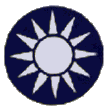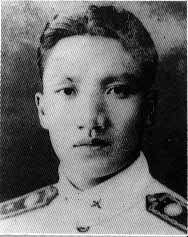China

Lieutenant Le Yi-Chin
China

Lieutenant Le Yi-Chin

1913 – 3 December 1937
Le Yi-Chin was born in 1913 and was a native of the Lu Shan County in the Szechuan Province.
After that the Japanese invaded Manchuria, he gave up his medical studies to become a pilot.
He graduated from the third class of the Central Flying School.
On 14 August the 4th PG moved to Schien-Chiao when Japanese troops landed in Shanghai. With the 3rd and 5th PG, the 4th PG became the main force in the defense of Shanghai and Nanking. At this time he was a Lieutenant and serving in the 22nd PS, which was equipped with Curtiss Hawk IIIs.
He took part in the first scramble from Schien-Chiao on 14 August, but his unit arrived to late to intercept the Japanese bombers.
During the night of 14 and 15 August the pilots of the 4th PG at Schien-Chiao airbase had to prepare their fighters themselves since the ground personnel had left the field to take shelter during the air raid on 14 August and had not returned. The pilots carried cans of fuel on their backs from the storage building to the field, punched holes on the cans and fuelled the aircraft themselves. They had not eaten since noon, and were not able to go to bed until 1:30 a.m. They did not sleep long because alarm sounded less than two hours later.
In the early morning on 15 August Colonel Kao Chi-Hang led 21 Hawk III's from the 4th PG to intercept a dawn attack on Hangchow by twelve Type 89 torpedo bombers from the Japanese carrier Kaga. In the confused action in and out of clouds, the 4th PG made 17 claims, more than the total number of Japanese planes in the action. The actual losses were six shot down and two ditched in Hangchow Bay.
Kao quickly shot down one of the Type 89's on the edge of the formation and then attacked another setting it alight. A lucky shot from the starboard quarter hit Kao in the right arm before passing through the instrument panel and damaging the engine in his Hawk No. IV-1. He was forced to land at Schien-Chiao and was out of action for 2 months.
21st PS's Squadron Leader Captain Lee Kuei-Tan in No. 2101 attacked the No. 2 Shotai, shooting down the No. 2 plane over Chao-Er. Two out of the crew of three were seen to bail out but they were over the Chao-er River and probably did not survive. Lee then teamed up with Lieutenant Cheng Hsiao-Yu of 22nd PS in No. 2202 to claim another Type 89. Return fire from the tightly packed Japanese formation was heavy and Lee's No. 2101 received slight damage to its upper wings while Cheng’s No. 2202 took a shot in one of its landing wheels. Cheng’s wingman, 2nd Lieutenant Chang Kuang-Ming also claimed a victory in this combat when he attacked the leader of a group of Japanese bombers. He opened fire with his two machine guns. Tracers and bullets truck his target, and the enemy plane turned into a fireball and plunged out of the sky. He broke off immediately and turned around for another strike.
Lieutenant Huang Yan-Po in No. 2107 attacked the first Shotai, claiming to have shot down the No. 3 aircraft in flames. He too took a shot in the landing wheel. Lieutenant Tan Won in No. 2104 also attacked the same Shotai and claimed another Type 89. This may have been the aircraft of the Kaga's Commander, Air Group (CAG) Commander Iwai who was killed in this action along with his deputy. Lieutenant Wang Wen-Hua caught two Type 89's trying to attack Schien-chiao from the south and shot one down in flames. One of the crew, a young ensign, bailed out and was captured. (This unnamed ensign later defected to the Chinese side and helped translate decoded Japanese radio messages). Lieutenant Yuan Chin-Han in No. 2108 went after the No.1 Shotai in a formation and claimed to have shot down the leader in flames (this may also have been Iwai's plane, it is almost certain that many Chinese pilots shot at the same planes). Lieutenant Liu Chi-Sheng in No. 2102 also claimed one Type 89 over Woong-Chia-Fu but was hit in the fuel tank and force landed at Chaio-shi Airfield where his plane was further damaged by bombing.
Lieutenant Le Yi-Chin from the 22nd PS made no less than 4 claims but these are almost certainly duplicates of other claims or overoptimistic.
Deputy Squadron C.O. Lai Ming-Tang landed to refuel and took off again to claim a shared kill with his wingman Lieutenant Liang Tian-Cheng.
Of the 23rd PS, Captain Mao Ying-Chu, Lieutenant Yang Yu-Ching and Lieutenant Wang Yin-Hua each claimed one Type 89.
On 21 August he claimed a Japanese fighter west of Shanghai.
At 10:00 on 20 September 32 Japanese aircraft raided Nanking.
Nine Chinese Hawk IIIs and two Boeing 281 s (no. 1706 and no. 1707) led by Squadron Leader Captain Liu Chui-Kang of the 24th PS, 5th PG were scrambled but didn’t intercept the Japanese formation. Suddenly six more Japanese bombers escorted by three fighters were spotted and attacked by Liu’s formation. Liu (Hawk III no. 2202) damaged a lagging enemy bomber before downing an E8N in the Nanking area. Lieutenant Le Yi-Chin (Hawk III ‘IV-1’) of 22nd PS, 4th PG, claimed a light enemy bomber west of Zhen-Jiang. Three of the Hawks suffered combat damage in this combat; Liu’s no. 2202, Le’s 'IV-1' and no. 2206. Boeing no. 1706 suffered some hit in the undercarriage and wings but all Chinese aircraft landed safely at 14:00.
The Japanese A5Ms returned claiming four victories. Three of these were claimed by PO1c Watari Handa from Kaga (victories nos. 2-4 of a total of 13 – 6 of them claimed in China).
By December 1937 Le served as deputy commander of 21st PS.
A group of nine I-16s flew out from Alma-Ata at the beginning of December 1937, led by Kombrig Petr Pumpur. The group flew to Lanzhou without any incidents. There they turned the I-16s over to the Chinese and returned to Alma-Ata in a transport aircraft for a new group of machines.
The Chinese pilots Tun, Lo and Li (flying Hawk IIIs) led the group on to Shanghai. Unfortunately the Soviet volunteers remembered at best distorted names of the Chinese, more like nicknames; and in Chinese sources the family names of Soviet are not understood either, and are written in ideographs, and therefore it is practically impossible to establish for certain the interaction between Soviet and Chinese pilots in the vast majority of cases. But in the given situation, it is known that the leaders were the new commander of the 4th PG Lee Kuei-Tan, the commander of the 21st PS, Teng Ming-Teh, and his deputy Le Yi-Chin. From the moment of arrival of this group at Shanghai were busy with the Japanese, and by the beginning of December the entire group had been deployed together with Chinese fighter units at Nanking.
On 3 December Teng Ming-Teh, commander of 21st PS (Hawk IIIs), 4th PG, and his deputy Lieutenant Le Yi-Chin took part in a combat over Nanking. During the combat Le Yi-Chin was shot down and killed.
Taking part in this attack on Nanking where Ki-10s of the 10th I F Chutai led by Captain Isao Abe escorted reconnaissance aircraft to the area, strafing Daijiaochang airfield, where two aircraft were claimed destroyed on the ground. Other attempted to intercept, and eight more were claimed shot down.
At the time of his death Le Yi-Chin was credited with 6 biplane victories, these being claimed while flying the Curtiss Hawk III.
His name can also be spelled as Lo I-Chin.
Claims:
| Kill no. | Date | Number | Type | Result | Plane type | Serial no. | Locality | Unit |
| 1937 | ||||||||
| 1 | 15/08/37 | 1 | Type 89 (a) | Destroyed | Curtiss Hawk III | #2204 | Hangchow area | 22nd PS |
| 2 | 15/08/37 | 1 | Type 89 (a) | Destroyed | Curtiss Hawk III | #2204 | Hangchow area | 22nd PS |
| 3 | 15/08/37 | 1 | Type 89 (a) | Destroyed | Curtiss Hawk III | #2204 | Hangchow area | 22nd PS |
| 4 | 15/08/37 | 1 | Type 89 (a) | Destroyed | Curtiss Hawk III | #2204 | Hangchow area | 22nd PS |
| 5 | 21/08/37 | 1 | Enemy fighter | Destroyed | Curtiss Hawk III | W Shanghai | 22nd PS | |
| 6 | 20/09/37 | 1 | Light enemy bomber | Destroyed | Curtiss Hawk III | 'IV-1' | W Zhen-Jiang | 22nd PS |
Biplane victories: 6 destroyed.
TOTAL: 6 destroyed.
(a) Claimed in combat with Type 89 torpedo bombers from the Japanese carrier Kaga. The Chinese pilots claimed 17 destroyed enemy aircraft but the actual losses were six shot down and two ditched in Hangchow Bay.
Sources:
Soviet Fighters in the sky of China, Part I - Anatolii Demin, 2000 Aviatsiia Kosmonavtika 9 (translated by George M. Mellinger)
Tidbits from the Sino-Japanese Air Battles - Chang Kuang-Ming, 1998 World News Weekly August 1998 kindly provided by Tom Chan
Information kindly provided by Raymond Cheung, Tom Chan and Erich Wang.


